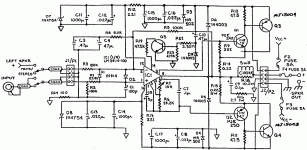I'm know just enough about electronics engineering to get myself in trouble, but I own this amplifier and it's been sitting for years as I have moved from solid state to, first Tripath and now higher powered Sure Electronics boards. I will never go back, however, I do have a question for those far more educated than myself.
This amplifier(Amber) is based on the Lm391 chip, and sounds wonderful, is this amplifier a direct precursor to the gainclone or exactly where does it fall in the progression toward where we are now in regards to 'chip-amps'?
Second question, in regards to this chip not having thermal overload tracking, would fitting a basic heatsink on the IC be a logical upgrade?
This amplifier(Amber) is based on the Lm391 chip, and sounds wonderful, is this amplifier a direct precursor to the gainclone or exactly where does it fall in the progression toward where we are now in regards to 'chip-amps'?
Second question, in regards to this chip not having thermal overload tracking, would fitting a basic heatsink on the IC be a logical upgrade?
LM391 was a dead-end. It is a minimal implementation of stuff that was done with discretes, often better. As you say they totally blew the thermal compensation (and no, heatsinking the DIP is no help). There's a fix, Amber did not do it. The LM3886 used in Gainclone is a significantly more sophisticated complete power amp.
If it "sounds wonderful" why are you messing with other lovers?
If it "sounds wonderful" why are you messing with other lovers?
That’s 40yrs ago, and while not all areas of audio electronics design have advanced at the same pace during the interim, I’d dare say that chip amps certainly have. As PRR notes, when implemented within the manufacturer’s guidelines, the LM3886 is certainly among that cohort. Note that it’s at least as easy to design a mediocre sounding and perhaps failure prone amp using op-amps/ monolithic chips as an excellent one, and that “magic” is mostly voluntary acceptance of well executed sleight of hand.
Chris, two thoughts. Firstly to clarify, the Amber is a suberb amplifier punching way above its weight, was a tiny boutique manufacturer that made an innovative product that still holds up to this day, you may know this already. If I had another, I would run them both bridged, with efficient drivers, Amber's suberb model 17 preamplifieran exceptional preamplifier on par easily with Yamaha Cx or Apt-Holman. I would never explore another SS setup.
So, aside from the Amber 70s trouble with heat when driving into 4ohm or lower loads, it is a great sounding amp, with obvious compromises/shortcomings.
As to your last point, don't I know it brother. Under the psycoacoustic spell of the dark arts, my soul wanders, vulnerable and human, from one harmonics dealer to the next, like a little baby with a checkbook.
So, aside from the Amber 70s trouble with heat when driving into 4ohm or lower loads, it is a great sounding amp, with obvious compromises/shortcomings.
As to your last point, don't I know it brother. Under the psycoacoustic spell of the dark arts, my soul wanders, vulnerable and human, from one harmonics dealer to the next, like a little baby with a checkbook.
Actually, the heat issue in the Amber 70 has nothing to do with the LM391 chip. Rather the emitter resistors are a tiny bit too small. The current ones are 0.25 Ohms and should be 0.30 Ohms. They need to be low inductance foil type resistors but I don't recommend changing them as it would affect the phase margin and overall stability of the amplifier. The correct way to adjust them is to redo the phase margin and stability design, which is beyond the ability most home DIY techs.
As a side note, some amps were shipped out with the output stage bias set too high. This wasn't a mistake, it was intentional to increase the Class A operation range. However, the more aggressive bias didn't account for the heatsink which was sized for a lower bias. And, of course, the smaller emitter resistors became more of a problem, too.
As a side note, some amps were shipped out with the output stage bias set too high. This wasn't a mistake, it was intentional to increase the Class A operation range. However, the more aggressive bias didn't account for the heatsink which was sized for a lower bias. And, of course, the smaller emitter resistors became more of a problem, too.
I have a 70 series in vgc just sitting around , could the boards be changed to class A boards lose the op amps ? Convert the amp to pure class A? I like the amp but am willing to experiment with it to improve . Heat sinks would need to be changed especially since I feel like they are plastic .
- Status
- This old topic is closed. If you want to reopen this topic, contact a moderator using the "Report Post" button.
- Home
- Amplifiers
- Chip Amps
- Amber Series 70?
